Weekly Arizona COVID-19 Data Report – Dr. Joe Gerald, April 23 Update
Note this forecast page is not the most recent forecast available.
View the most current forecast report
Researcher Analyzes Arizona COVID-19 Spread Models for Decision-Makers
The following information regarding the spread of COVID-19 in Arizona was prepared by Joe Gerald, MD, PhD, a researcher at the Mel and Enid Zuckerman College of Public Health (MEZCOPH) at the University of Arizona. This information has also been reviewed by other MEZCOPH faculty.
This data were obtained from the Arizona Department of Health Services COVID-19 webpage and reflect conditions in Arizona as of April 23, 2021.
This information is intended to help guide our response to the outbreak. It is not intended to predict how this pandemic will evolve. Rather, this model extrapolates what might occur if current conditions remain unchanged. As regional authorities and healthcare providers respond, their actions are expected to mitigate the worst consequences of this pandemic.

COVID-19 Disease Outbreak Forecast
Arizona State and Pima County
Updated April 23, 2021
Disclaimer: This information represents my personal views and not those of The University of Arizona, the Zuckerman College of Public Health, or any other government entity. Any opinions, forecasts, or recommendations should be considered in conjunction with other corroborating and conflicting data. Updates can be accessed at https://publichealth.arizona.edu/news/2021/covid-19-forecast-model.
For the week ending April 18th, 5014 Covid-19 cases were diagnosed in Arizona (Figure 1). This represents a 6% increase from last week’s initial tally of 4726 cases and marks the fourth week of slowly increasing rates. The prior week’s tally was upwardly revised by 1% (31 cases) to 4757 cases this week. Case rates among those ≥65 years of age remain below those of children, 28 versus 49 cases per 100K residents per week, respectively (Figure 2). The highest rates are among those 15 – 24 years and 25 – 64 years of age, 116 and 81 cases per 100K residents per week, respectively.
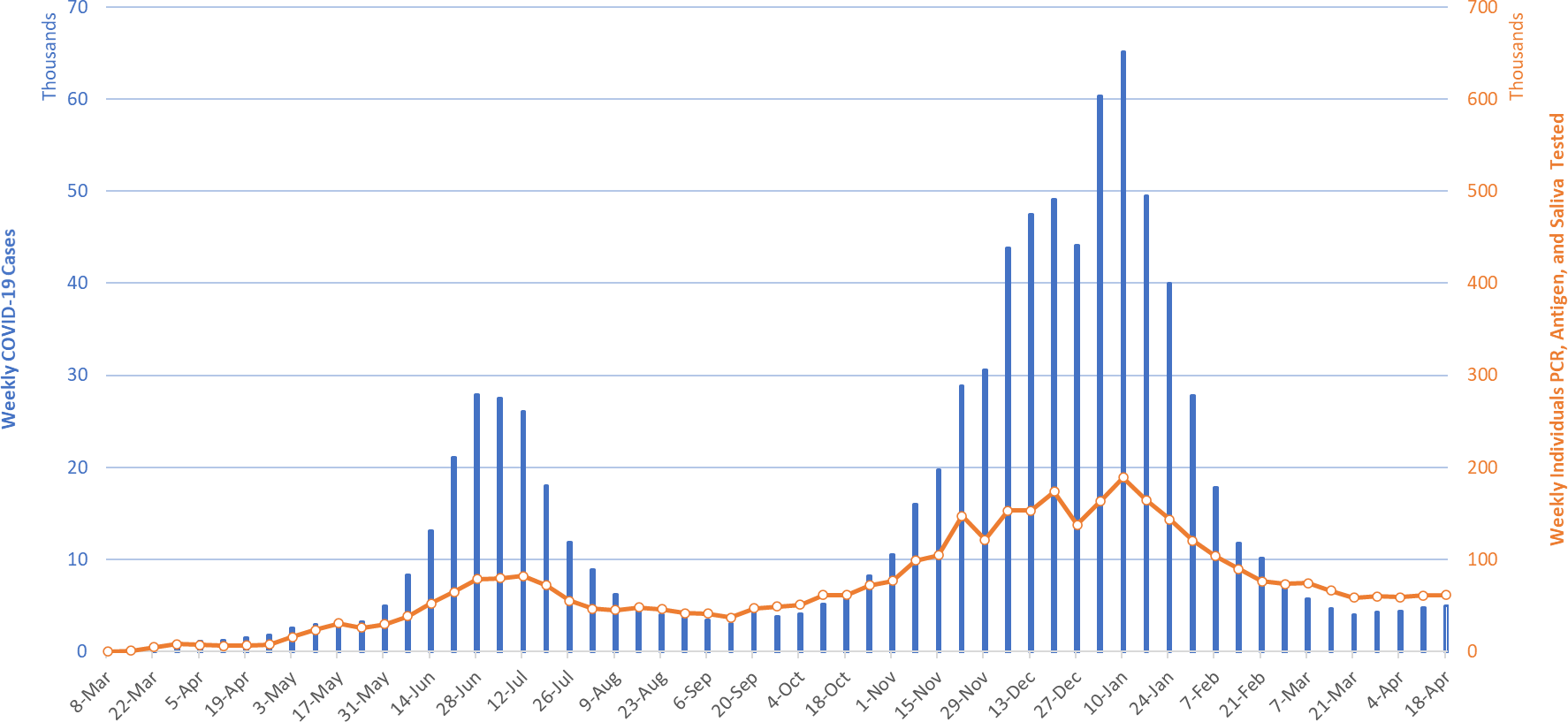
|
Figure 1. Newly Diagnosed Covid-19 Cases in Arizona and Number of Individuals Undergoing Covid-19 Diagnostic Testing March 1, 2020 through April 18, 2021. |
Arizona case rates remain “stuck” just above the threshold differentiating substantial and moderate risk owing to more transmissible variants (e.g., B.1.1.7) and normalization of business and social activities (e.g., EO 2021- 06). According to the CDC, vaccination rates continue to increase with 34% of Arizona’s adult population being fully vaccinated and another 15% having received one dose (49% with ≥1 dose). With 78% of the ≥65 population having received ≥1 dose, Arizona ranks in the bottom half of states.
New cases are now being diagnosed at a rate of 70 per 100K residents per week; this rate is slowly increasing. For reference, September 8th marked the fall nadir between the summer and winter outbreaks at 38 cases per 100K residents per week. The post-holiday nadir was 53 cases per 100K residents on March 23, 2021. Unvaccinated Arizonans who are at risk of developing severe disease (e.g., age or comorbid conditions) or who simply wish to remain uninfected should continue to shelter as much as feasible because viral activity remains widespread.
Note: Data for this report was updated Friday, April 23 allowing 4 full days to adjudicate cases and keep week-over-week backfill 10%. This allows more interpretable comparisons and graphics. All comparisons are week-over-week changes.
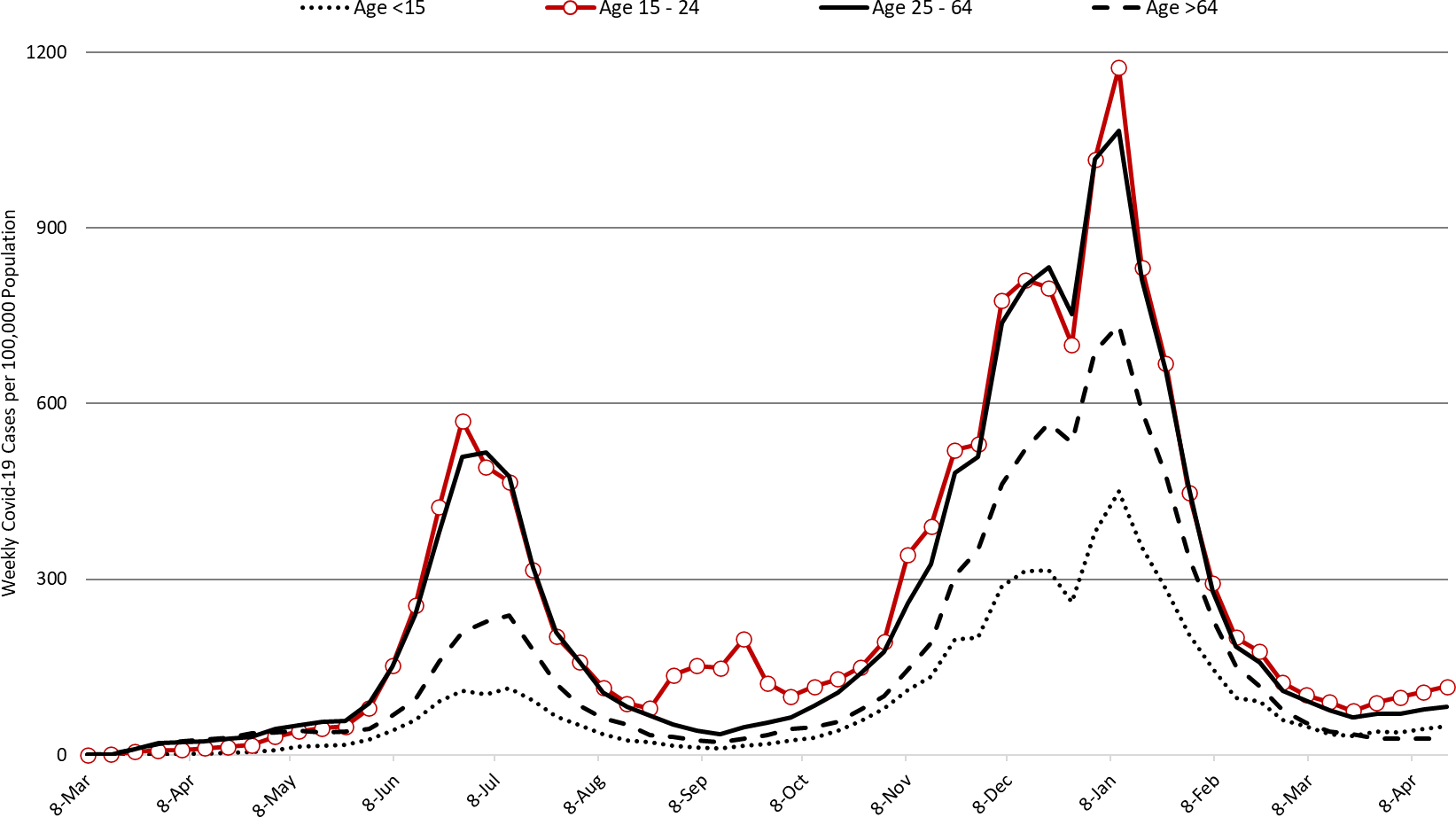
|
Figure 2. Newly Diagnosed Covid-19 Cases in Arizona by Age Group March 1, 2020 through April 18, 2021. |
Test positivity among those undergoing traditional nasopharyngeal PCR testing is slowly increasing; positivity was 10% this week (Figure 3). Positivity remains within the 5 – 10% window for optimal public health practice.
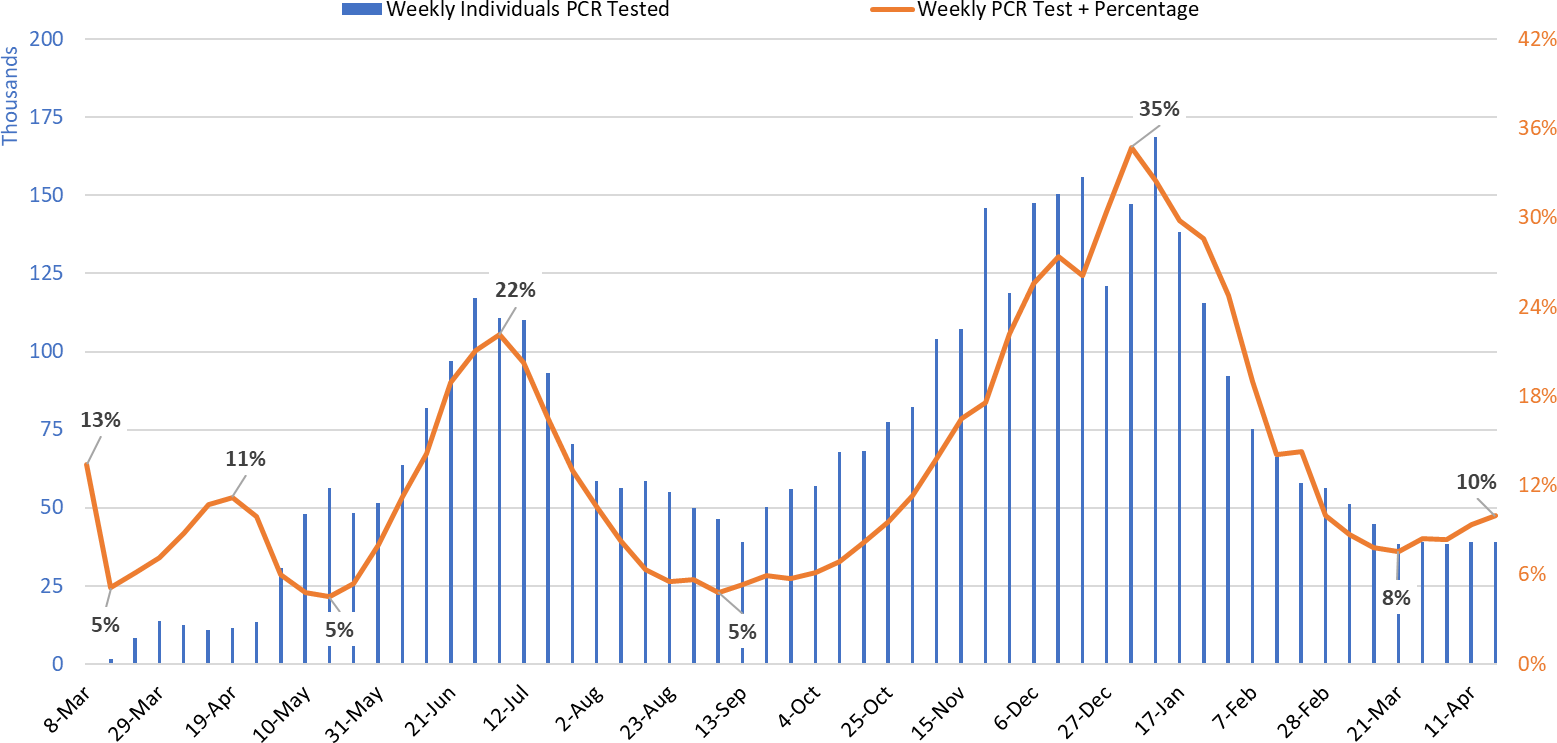
|
Figure 3. Weekly Number Patients Undergoing Traditional Nasopharyngeal PCR Testing and Associated Percent Positivity March 1, 2020 – April 18, 2021. |
As of April 22nd, 594 (7%) of Arizona’s 8605 general ward beds were occupied by Covid-19 patients, a 4% increase from the previous week’s 569 occupied beds (Figure 4 and Figure 5 Panel A). Another 912 (11%) beds remained available for use. The number of available beds is lower than the previous week’s 1025 beds.
Covid-19 occupancy has dropped by 88% from its January 11th peak of 5082 ward patients. The summer-fall nadir was 468 occupied beds on September 27th. The post- holiday nadir was 516 beds on April 4.
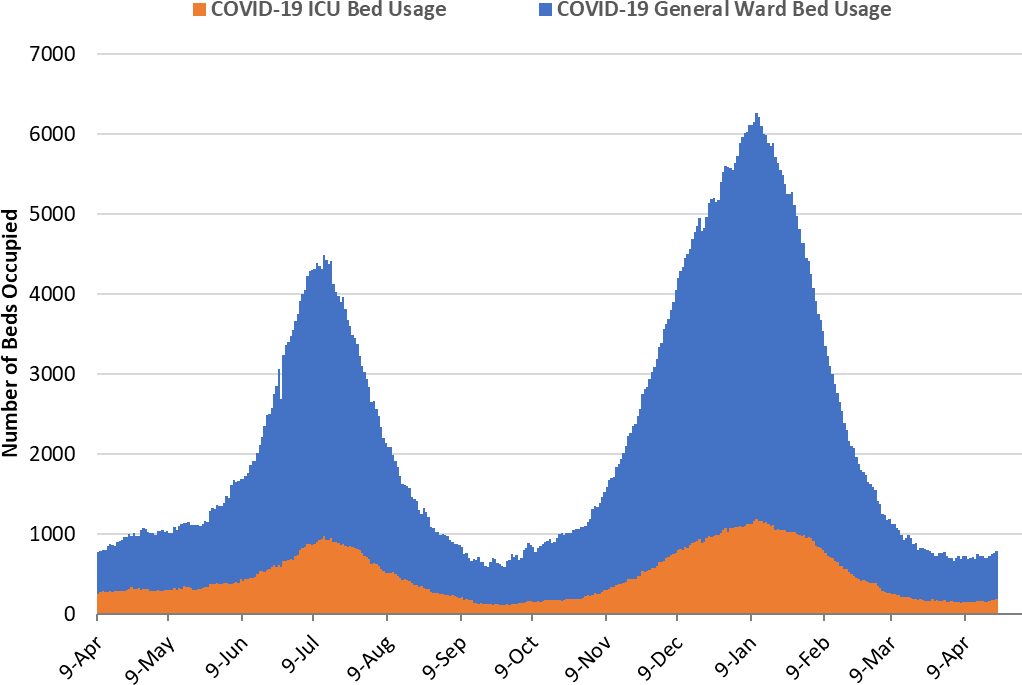
|
Figure 4. Arizona Daily Covid-19 General Ward and ICU Census April 20, 2020 – April 22, 2021. |
As of April 22nd, 187 (11%) of Arizona’s 1727 ICU beds were occupied with Covid-19 patients, a 21% increase from the prior week’s count of 154 patients (Figure 4 and Figure 5 Panel B). An additional 253 (15%) ICU beds remained available for use. This is similar to the prior week’s 254 available beds. ICU occupancy has fallen 84% from its January 11th peak of 1183 occupied beds. The summer-fall nadir was 114 occupied beds on September 22nd. The post-holiday nadir was 140 beds on April 7.
|
Figure 5. Covid-19 Occupancy as a Percent of Listed General Ward (A, left) and ICU (B, right) Capacity in Arizona April 20, 2020 – April 22, 2021. |
Arizona hospital occupancy remains above seasonal trends. Improvements in ward and ICU occupancy remain stalled at ≥85% occupancy (Figure 6). This indicates that medically necessary procedures that were previously postponed are being scheduled at higher than seasonal amounts to address the backlog of care. It will still take several more months to resolve. Occupancy will need to fall 70-75% before conditions will be back to “normal.” As capacity constraints are lessened, care practices should return to those prior to the outbreak ensuring all patients will receive optimal care. Hospitals will remain crowded through May before returning to pre-outbreak levels.
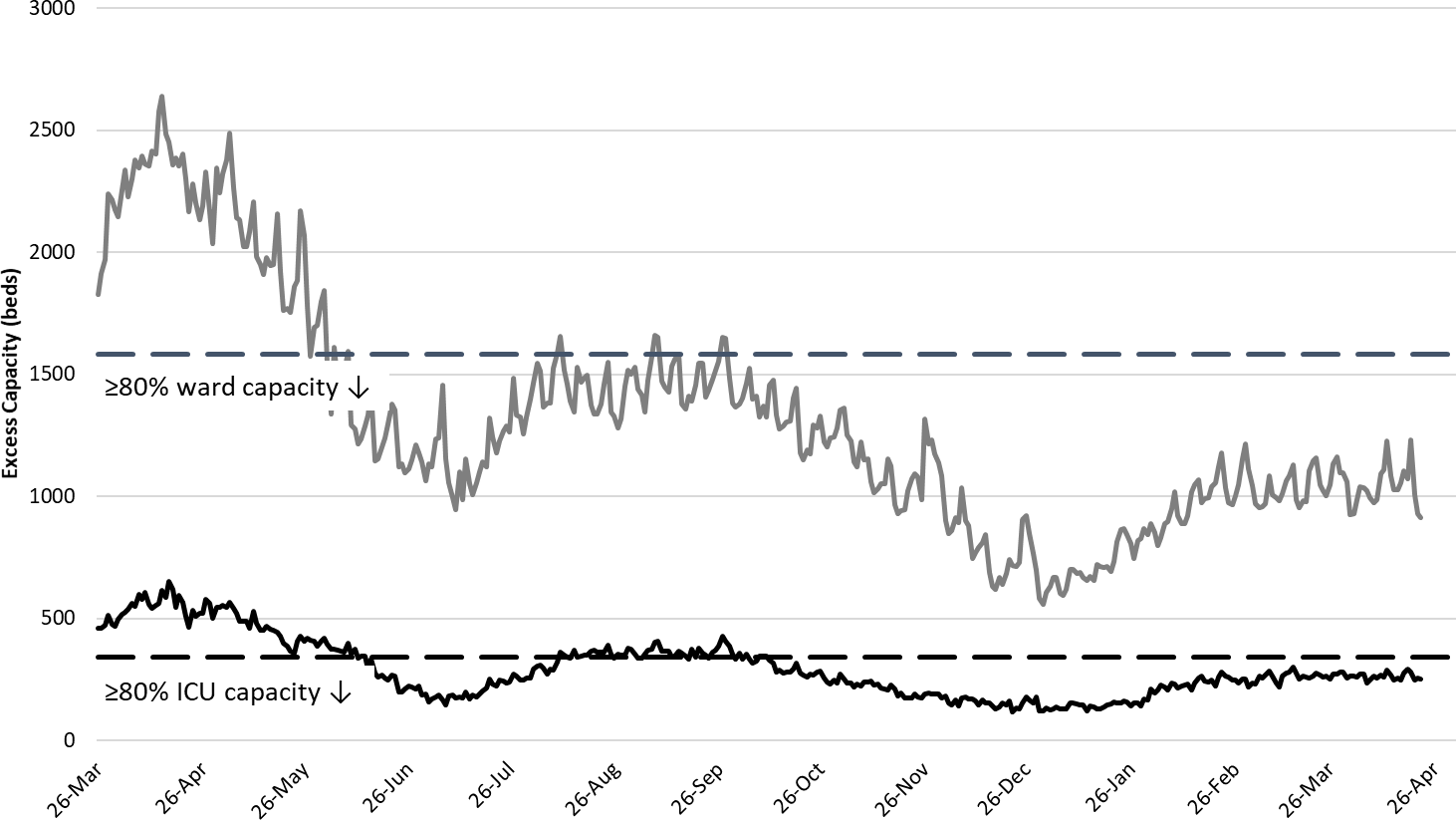
|
Figure 6. Observed Excess Non-Surge General Ward and ICU Capacity April 20, 2020 – April 22, 2021. |
The week ending January 17th remains Arizona’s deadliest with 1089 deaths (Figure 7). With 193 deaths recorded, March 7th may become the first week with 200 Covid-19 deaths since November. The summer – fall nadir was 51 deaths the week ending October 4th.
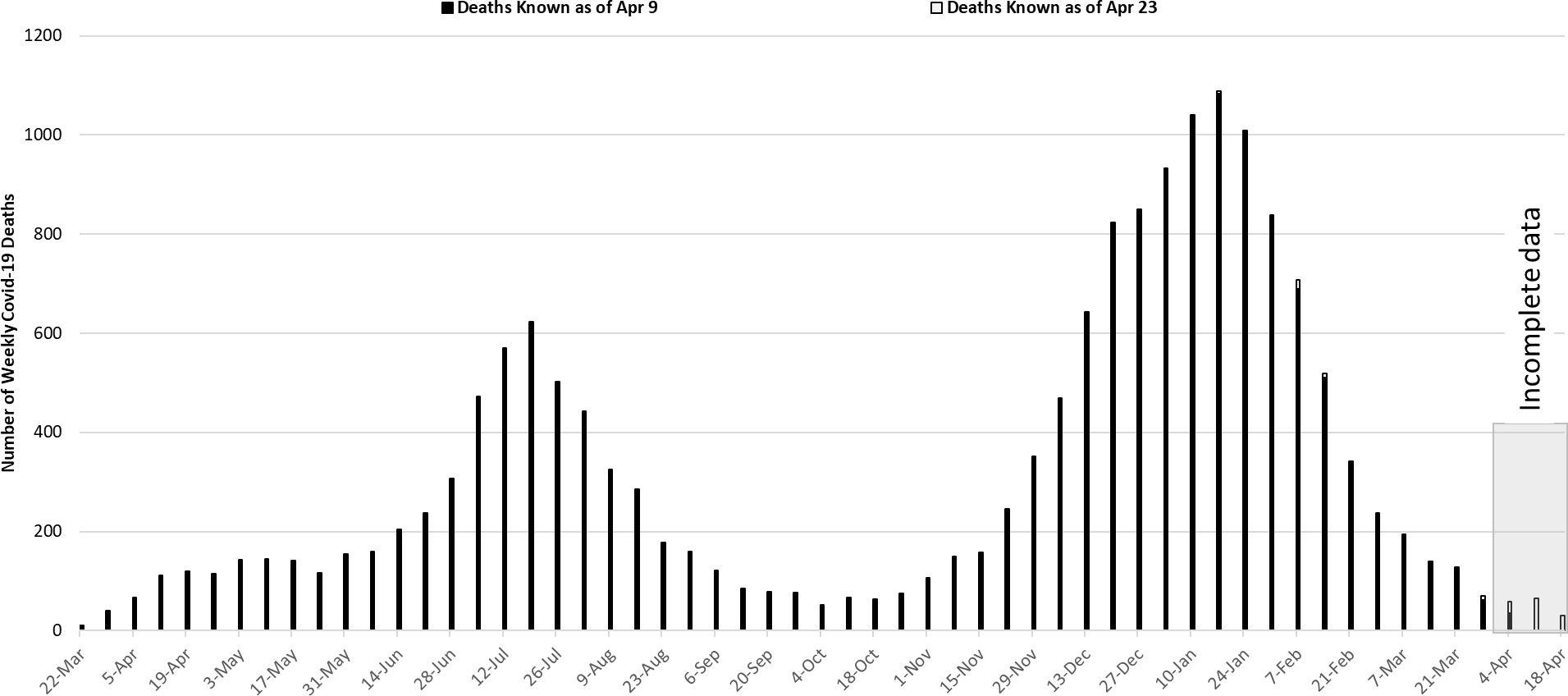
|
Figure 7. Weekly Arizona Covid-19 Deaths March 1, 2020 – April 22, 2021. |
Pima County Outlook
For the week ending April 18th, 569 Pima County residents were diagnosed with Covid-19. This is a 7% decline from the 609 cases initially reported last week (Figure 8). Last week’s initial tally was upwardly revised by 2% (11 cases) to 620 cases.
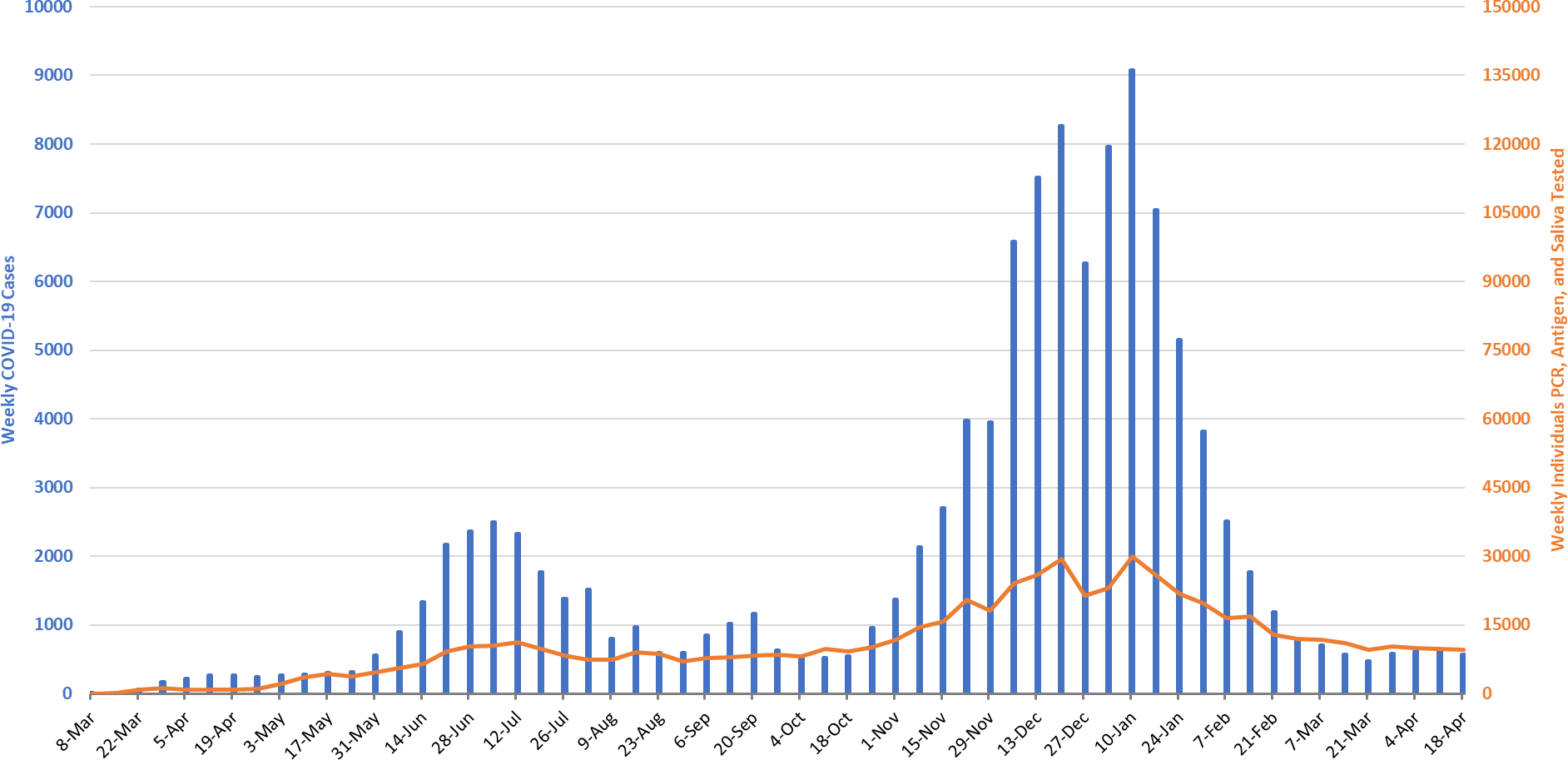
|
Figure 8. Covid-19 Cases and Individuals Undergoing Testing in Pima County Mar 1, 2020 – Apr 18, 2021 |
New cases are being diagnosed at a rate of 55 cases per 100K residents per week and is slowly decreasing. For reference, October 9th marked a nadir between the summer and winter outbreak at 46 cases per 100K residents per week. Case rates reached their lowest post-holiday level at 44 cases per 100K residents per week on March 20th. Trends across the various age groups appear in Figure 9.
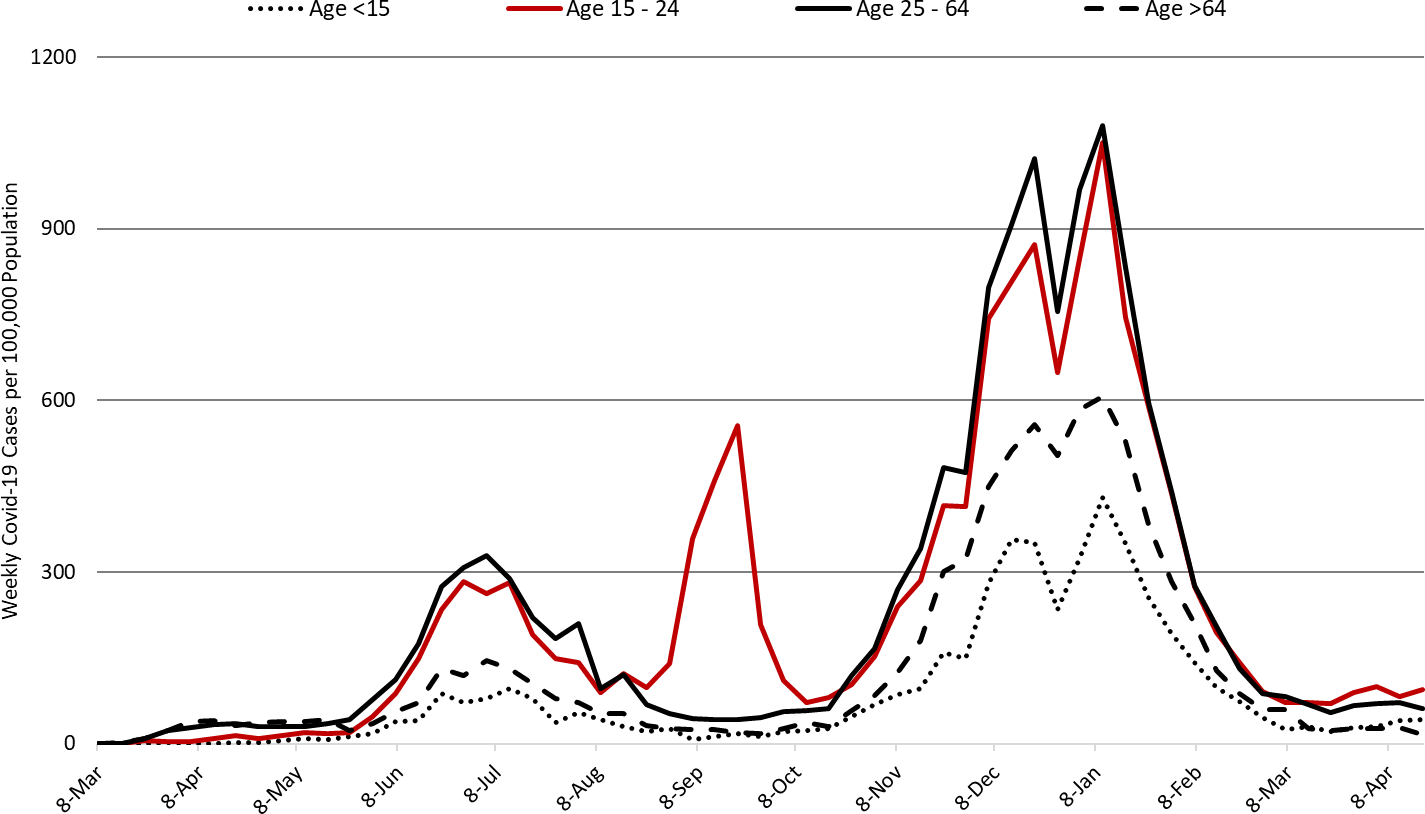
|
Figure 9. Covid-19 Cases by Age Group in Pima County from March 1, 2020 – April 18, 2021. |
Summary
- This week saw another small increase in Covid-19 cases and hospitalizations, particularly in the ICU. Arizona’s most populous counties now have absolute levels of SARS-CoV-2 viral transmission >50 cases per 100,000 residents per week which demarcates substantial and moderate risk (see CDC Recommended Mitigation Strategies for K – 12 Learning Modes).
- As of April 18th, new cases were being diagnosed at a rate of 70 cases per 100,000 residents per week. This rate is slowly increasing by approximately 6 cases per 100,000 residents per week.
- All unvaccinated residents should continue to wear a mask in public, avoid large social gatherings, maintain physical distance from non-household contacts, avoid >15 minutes contact in indoor spaces, especially if physical distancing is inadequate and adherence to face masks is low.
- Fully vaccinated residents (2 weeks post final dose) are now being afforded a greater freedom of movement and the ability to gather in small, low-risk groups, by the CDC.
- Test positivity for traditional nasopharyngeal PCR testing is now 10% which is within the recommended 5 – 10% range for optimal public health practice.
- Hospital Covid-19 occupancy is increasing slightly in the ward and ICU. Access to care remains somewhat restricted as occupancy remains unseasonably high while the backlog of medically necessary non-Covid procedures is being addressed.
- Arizona Covid-19 fatality count should fall below 100 deaths per week soon and then hold steady. With about 5000 weekly cases and a 1.5% case fatality rate, there should be approximately 75 deaths 3 – 4 weeks from now. Worrisomely, the post-recovery sequala of SARS-CoV-2 includes a 50% higher risk of death through 3 – 6 months along with higher rates of illness and health care use (See Al-Aly below).
- According to the CDC, 34% of Arizona adults have received at least 2-doses of vaccine while another 15% have received 1-dose. So far, the vast majority who start the vaccination process complete it. However, Arizona passed peak vaccination rates several weeks ago indicated progress towards our goal is slowing.
Reading of Interest this Week:
- Al-Aly Z. High-Dimensional Characterization of Post-Acute Sequalae of COVID-19. Nature. 2021; e-pub ahead of print. DOI:10.1038/s41586-021-03553-9. (See link)
- Haffner MR. Postoperative In-Hospital Morbidity and Mortality of Patients with COVID-19 Infection Compared with Patients without COVID-19 Infection. JAMA Netw Open. 2021;4(4):e215967. DOI: 10.1001/jamanetworkopen.2021.5697. (See link)
- Villar J. Maternal and Neonatal Morbidity and Mortality among Pregnant Women with and without COVID- 19 Infection: The INTERCOVID Multinational Cohort Study. JAMA Pediatrics. 2021; e-pub ahead of print. (See link)
- Callison K. Associations between Individual Demographic Characteristics and Involuntary Health Care Delays as a Result of COVID-19. Health Aff (Millwood). 2021; 40(5): e-pub ahead of print. (See link)
- Teran RA. Postvaccination SARS-CoV-2 Infections among Skilled Nursing Facility Residents and Staff Members – Chicago, Illinois, December 2020 – March 2021. MMWR. 2021; 70 (April 21) early release. (See link)
- Cavanaugh AM. COVID-19 Outbreak Associated with a SARS-CoV-2 R.1 Lineage Variant in a Skilled Nursing Facility after Vaccination Program – Kentucky, March 2021. MMWR. 2021; 70 (April 21) early release. (See link)
Forecast reports to date, available as PDFs
Download PDF to view additional charts of Arizona counties, available in appendix of report.
2020 Reports
Based on what we know now about this pandemic, we support guidelines for social distancing to slow the spread of the virus and urge everyone to follow the recommendations provided by the Centers for Disease Control and Prevention (CDC) to protect yourself, your family, your neighbors, and your employees. Please heed the recommendations as provided by the CDC.
COVID covid coronavirus virus covid19 corona forecast model

